Myakka River State Park, formally established and opened to visitors in 1941, is one of Sarasota County’s unique and precious treasures. In late January, I had the opportunity to join a Florida Department of Environmental Protection biologist at Myakka River State Park to survey 14 miles of the Myakka River by kayak, to better understand the state of the river and the wildlife it supports, as well as some of the conservation issues this spectacular ecosystem faces.
In the blog series “Wild and Scenic”, you can experience a day in the life of a biologist on the Myakka River and get an inside perspective on what’s going on “beneath the surface”. If you haven’t read parts 1 and 2 of the “Wild and Scenic” series, be sure to check them out first!
The Journey So Far
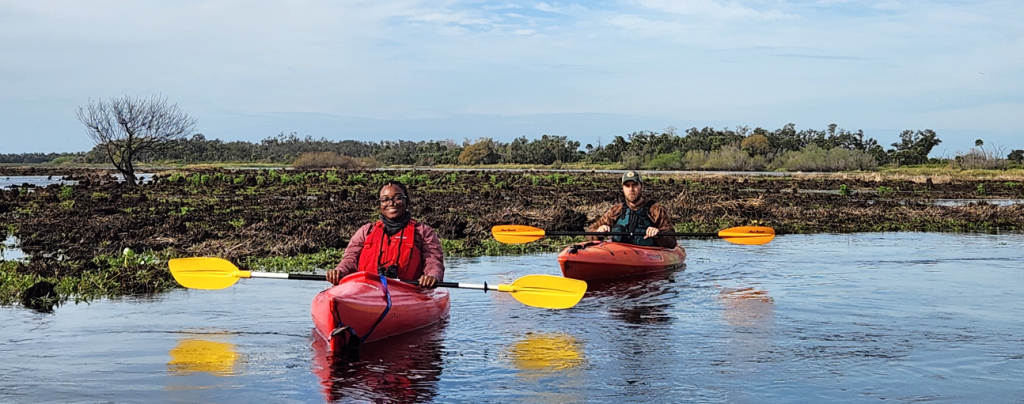
In part 2 of this series, we met Chris Oliver, Florida Department of Environmental Protection’s Myakka Wild and Scenic River Biologist and began a 14-mile kayak journey down the Myakka River to survey the ecosystem.
I shared the impact that invasive plant species can have on Florida’s ecosystems, a restoration success story, and a surprise run in with a green water snake.
As we left behind smooth sailing along the soft curves of the river, ahead lay Myakka River’s Lower Lake and Deep Hole- a place where visitors hike out for a little over 2 miles to marvel at the large numbers of congregating alligators.
A Local Wonder
As part of the Wilderness Preserve area, permits are required to hike to Deep Hole, and only 30 are given out each day to protect the habitat and wildlife that depend on it. Deep Hole is a sinkhole that formed many, many years ago near the edge of Myakka River State Park’s Lower Lake. Due to its depth of 131ft., this geological wonder remains a deep-water escape during the dry season. As such, an abundance of birds, fish, alligators, and other wildlife can be found foraging, hunting, and seeking refuge in and around Deep Hole.
From 2011-2012, a collaborative research team including individuals from Mote Marine Laboratory, the ADM Exploration Foundation, and Sarasota County Water Resources set out with the help of Myakka River State Park rangers to better understand Deep Hole’s water chemistry and geology (Culter et al., 2013). Equipped with a submerged, backup shark diving cage in case of encounters with large alligators in the low-visibility water, a team of technical divers worked to explore and map the depths of Deep Hole (Culter et al., 2013). You can read more about their findings here.
Traversing the Lower Lake
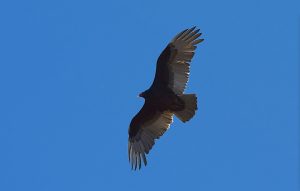
As we left the shallow restoration area, a large “kettle” of black and turkey vultures soared over head, riding currents of rising warm air. With trained eyes, Chris and Ben, a dedicated Myakka River State Park volunteer who often assists Chris on his surveys, were able to count 81 of them as they circled, bringing our total to 106 for the day.

Entering Deep Hole
We crossed the lake and passed through a small, shallow channel where aquatic grasses grew from the water, spotting our first few basking alligators amongst the grasses. We had made it to Deep Hole!
A few hikers and a volunteer were observed standing on the shoreline. Without knowledge of the geological wonders beneath the surface, one might think that Deep Hole was simply another part of the river. Alligators of various sizes were piled on top of one another in one corner of the shoreline, and others peered at us from within the water.
When counting alligators, Chris would categorize them by length in feet as either a 0-4, 4-6, 6-8, or over 8, and noted whether they were observed fully in the water, partially on land, or completely on land. Details are important when observing wildlife behavior.
How Many Is Enough?
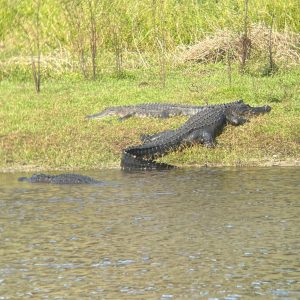
In roughly 8 hours of paddling the 14-mile stretch of the Myakka River, Chris and Ben counted around 81 alligators. While seeing 81 alligators in one day may be more than most people tend to see, this number was down from the previous month’s 92, and even other months, where hundreds could be seen. In fact, according to Chris, there are some indications that numbers of alligators recorded in key areas such as Deep Hole may be declining.
Of course, not every alligator in the environment will be noticed by human eyes, and seasonality, time of year, and weather all impact where alligators are and when. Month to month changes may not be a reliable indicator of overall population trend, so noticing trends in data gathered over years of doing the same survey at the same time of day give a better picture of a population or ecosystem’s health.
Why Do We Need Healthy Alligator Populations?
While there are a little over 1 million alligators in the state of Florida, these large reptiles play an essential role in our unique ecosystems and should not be taken for granted.
From acting as ecosystem engineers creating habitat for other wildlife in the form of alligator holes, to serving as both apex predators as adults and food for other animals as juveniles, each alligator has an important job to do! The presence of alligators around bird rookeries can even aid in the survival of young wading birds that are still in the nest.
Flushing Wildlife
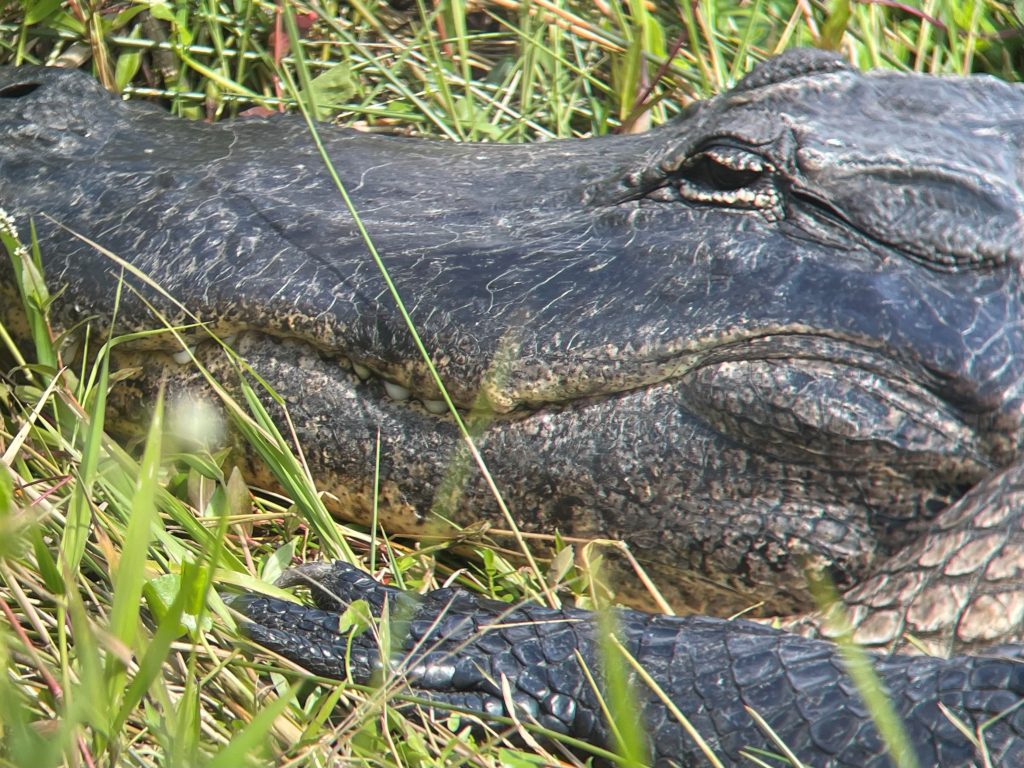
Throughout the day, I saw alligators of all sizes, from 1 foot-long juveniles basking atop downed cabbage palms in the warm sunlight, to the largest alligator of the day resting above us on a high point of the bank as we rounded a bend in the river. Despite trying to give this alligator as much space as we could in this narrow section, after eyeing us up, it jumped into the water with a huge splash!
Similarly to this adult alligator, most basking gators that noticed our presence quickly entered the water for cover and a sense of safety. This occurrence is referred to as “flushing”.
When animals flush, they quickly alter their behavior and abandon what they were doing due to feeling threatened. This often happens due to humans getting too close to wildlife. A good rule of thumb when viewing wildlife is that if your presence causes an animal to change its behavior, then you are too close.
Going once…going twice….gone!
What’s the big deal if a bird has to fly to another location, or if an alligator has to get in the water? For humans in some parts of the world, when we want food, we can have it delivered to our house or purchase it from a grocery store if we have the means to. This level of convenience is not the reality for wildlife, who must expend energy to acquire enough food to survive. Animals generally prioritize the conservation of energy, and a high energy activity such as flying is a use of calories that they will need to replace.
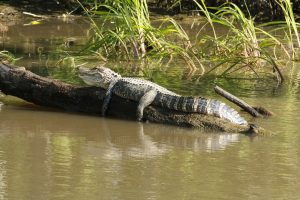
In the case of ectothermic reptiles like alligators, they regulate their body temperature using their environment. A basking alligator is not just being lazy! They utilize warm sunlight to regulate their body temperature and enable vital physiological functions.
Being startled and quickly entering the water has a cost to that alligator, and just like us, stress negatively impacts wildlife as well.
Chris clearly outlined the potential cumulative impact of wildlife being consistently flushed from the same area: over time, they may abandon that habitat, because it is no longer a safe area where they can meet their needs without feeling threatened. Remember to always stay back, relax, and observe from a respectful and safe distance!
Staying Safe
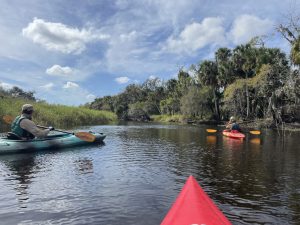
When paddling in alligator territory (which is potentially any body of freshwater in Florida, and sometimes even brackish water), it is important to always keep as much space between yourself and any alligators you see as possible. Sometimes you may come upon one by surprise, in which case you can calmly continue to paddle away and put distance in between you and the reptile. Never intentionally approach, corner, harass, or attempt to touch an alligator, whether in the water or on land.
Alligators generally avoid humans and will enter the water where they can hide and feel safe. Being able to paddle safely in Florida’s waters requires all of us to pitch in by never feeding alligators, and ensuring that while fishing, fish entrails and parts are not discarded in the water, along the water’s edge, or thrown off of boats, as these behaviors may lead alligators to associate humans with an easy food source. Never allow fish caught on a line to trail alongside or behind your watercraft.
We’re Almost There!
Whew, what a fascinating day in the life of a Myakka River Wild and Scenic Biologist! Head over to part 4 of the “Wild and Scenic” blog series to find out how we finished up this day, what other species were observed, and some of the conservation issues Chris has identified as threats to the Wild and Scenic Myakka River ecosystem.
Find all of the blogs in this series here:
Wild and Scenic: A Day in the Life of a Biologist on the Myakka River Part 1
Wild and Scenic: A Day in the Life of a Biologist on the Myakka River Part 2
Wild and Scenic: A Day in the Life of a Biologist on the Myakka River Part 4
Sources
Bowen, C., Cutler, J. K., Janneman, R., Lin, W., Perry, J., Ryan, J. (2013). Exploration of Deep Hole, Myakka River State Park, Florida. Sarasota Water Atlas. https://sarasota.wateratlas.usf.edu/upload/documents/2013-DeepHole-CulterML_mdjs.pdf
 1
1
